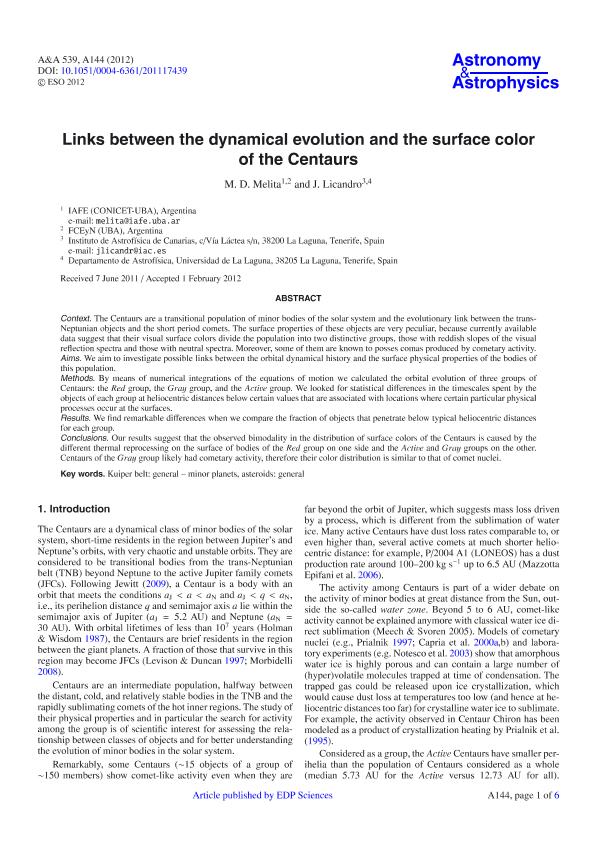Mostrar el registro sencillo del ítem
dc.contributor.author
Melita, Mario Daniel

dc.contributor.author
Licandro, J.
dc.date.available
2017-06-22T18:52:17Z
dc.date.issued
2012-02-21
dc.identifier.citation
Melita, Mario Daniel; Licandro, J.; Links between the dynamical evolution and the surface color of the Centaurs; Edp Sciences; Astronomy And Astrophysics; 539; 1; 21-2-2012; 144-155
dc.identifier.issn
0004-6361
dc.identifier.uri
http://hdl.handle.net/11336/18685
dc.description.abstract
Context. The Centaurs are a transitional population of minor bodies of the solar system and the evolutionary link between the trans- Neptunian objects and the short period comets. The surface properties of these objects are very peculiar, because currently available data suggest that their visual surface colors divide the population into two distinctive groups, those with reddish slopes of the visual reflection spectra and those with neutral spectra. Moreover, some of them are known to posses comas produced by cometary activity. Aims. We aim to investigate possible links between the orbital dynamical history and the surface physical properties of the bodies of this population. Methods. By means of numerical integrations of the equations of motion we calculated the orbital evolution of three groups of Centaurs: the Red group, the Gray group, and the Active group. We looked for statistical differences in the timescales spent by the objects of each group at heliocentric distances below certain values that are associated with locations where certain particular physical processes occur at the surfaces. Results. We find remarkable differences when we compare the fraction of objects that penetrate below typical heliocentric distances for each group. Conclusions. Our results suggest that the observed bimodality in the distribution of surface colors of the Centaurs is caused by the different thermal reprocessing on the surface of bodies of the Red group on one side and the Active and Gray groups on the other. Centaurs of the Gray group likely had cometary activity, therefore their color distribution is similar to that of comet nuclei.
dc.format
application/pdf
dc.language.iso
eng
dc.publisher
Edp Sciences

dc.rights
info:eu-repo/semantics/openAccess
dc.rights.uri
https://creativecommons.org/licenses/by-nc-sa/2.5/ar/
dc.subject
Kuiper Belt, General
dc.subject
Asteroides Centauros
dc.subject
Planetas Menores
dc.subject
Asteroides
dc.subject.classification
Astronomía

dc.subject.classification
Ciencias Físicas

dc.subject.classification
CIENCIAS NATURALES Y EXACTAS

dc.title
Links between the dynamical evolution and the surface color of the Centaurs
dc.type
info:eu-repo/semantics/article
dc.type
info:ar-repo/semantics/artículo
dc.type
info:eu-repo/semantics/publishedVersion
dc.date.updated
2017-06-21T18:56:09Z
dc.journal.volume
539
dc.journal.number
1
dc.journal.pagination
144-155
dc.journal.pais
Francia

dc.journal.ciudad
Paris
dc.description.fil
Fil: Melita, Mario Daniel. Consejo Nacional de Investigaciónes Científicas y Técnicas. Oficina de Coordinación Administrativa Ciudad Universitaria. Instituto de Astronomía y Física del Espacio. - Universidad de Buenos Aires. Facultad de Ciencias Exactas y Naturales. Instituto de Astronomía y Física del Espacio; Argentina
dc.description.fil
Fil: Licandro, J.. Instituto de Astrofísica de Canarias; España. Universidad de la Laguna; España
dc.journal.title
Astronomy And Astrophysics

dc.relation.alternativeid
info:eu-repo/semantics/altIdentifier/url/https://www.aanda.org/articles/aa/abs/2012/03/aa17439-11/aa17439-11.html
dc.relation.alternativeid
info:eu-repo/semantics/altIdentifier/doi/http://dx.doi.org/10.1051/0004-6361/201117439
Archivos asociados
